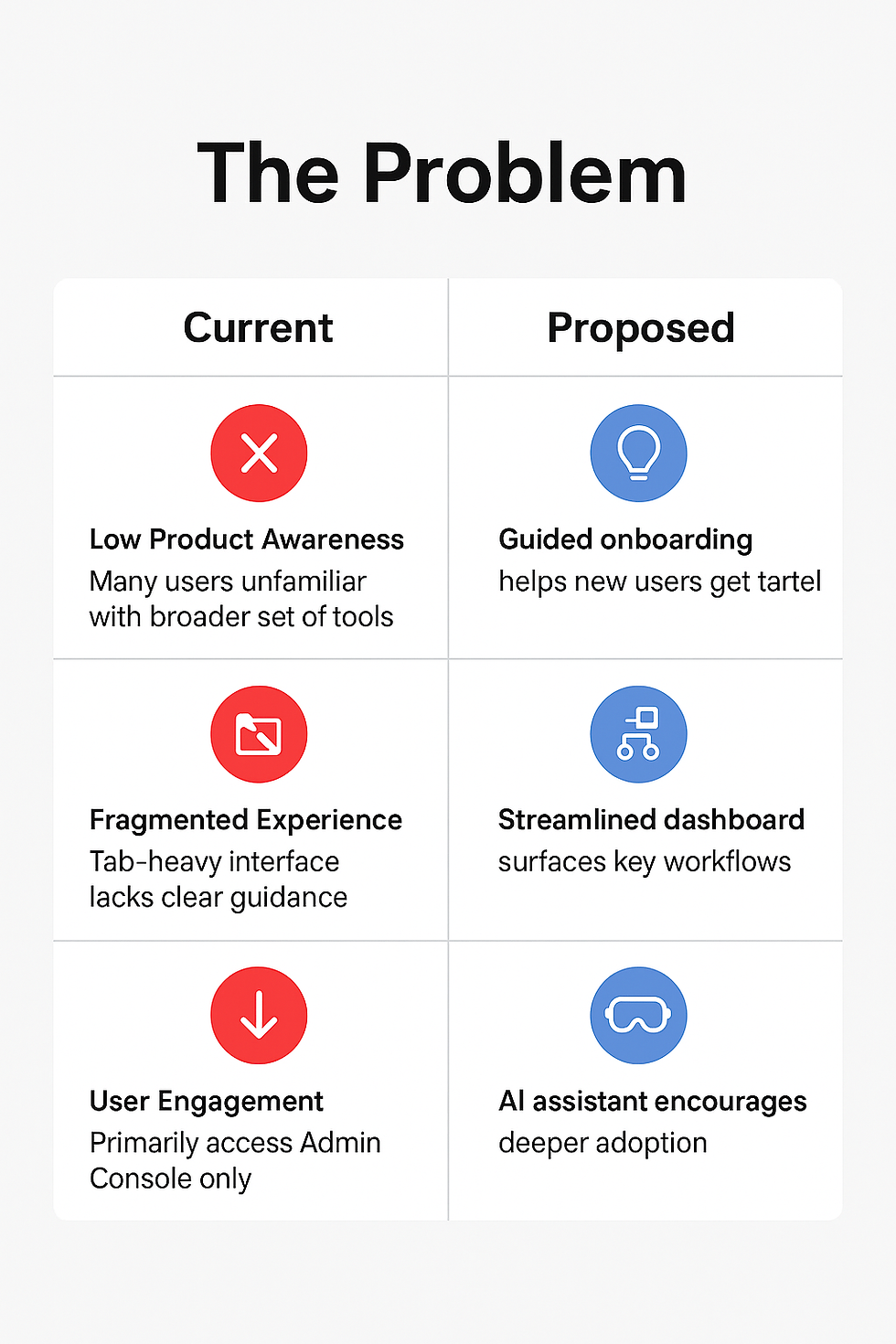

RTI
Improving Launcher UX
Case Study: Improving Launcher User Experience
Scenario
RTI Launcher serves as the primary interface for deploying, configuring, and managing Connext components in on-premise environments. It is designed to be a "one-stop hub" where users can access a suite of tools such as Admin Console, Monitor, System Designer, and various services and utilities. Despite this, many customers—particularly those new to Connext—use Launcher primarily to access only the Admin Console, ignoring the broader functionality.
This limited usage stems from two core challenges:
● Low Product Awareness:
Many users, particularly those new to Connext or less familiar with the underlying DDS architecture, are unaware of the full range of capabilities within Launcher. The current interface, tab organization, and terminology can be overwhelming or confusing, making it difficult for users to discover other tools like Monitor, Routing Service, System Designer, or even the Learn tab.
● Fragmented User Experience:
The Launcher’s current design presents tools in a tab-based interface, each populated with XML-driven buttons and configurations. While powerful, this design offers little guidance or context for new users. Without a clear “getting started” path or guided onboarding, users tend to default to what they recognize—Admin Console—and miss out on other features that could streamline their workflows and enhance system observability.
This scenario results in underutilization of Connext’s capabilities, missed opportunities for efficiency, and potentially higher support burden as users struggle with tasks that other tools within Launcher could simplify.
Objective: To improve the RTI Launcher experience for users with low awareness of Connext components, especially those who currently use only Admin Console. The goal is to identify gaps in the user journey, propose actionable design improvements, craft a compelling business value proposition for internal stakeholders, and outline a validation plan.
User Personas
Research identified two representative user personas that illustrate the challenge:
Priya (New User)
Goals: Install Connext, run examples, and learn DDS basics.
Journey: Ends up only in Admin Console, missing key tools.
Feeling: Confused and discouraged.
David (Experienced User)
Goals: Manage installations, quickly access known tools, run diagnostics.
Journey: Completes tasks efficiently but unaware of broader features.
Feeling: Satisfied, but with unrealized potential.
Recommended Solutions
Immediate UX & Technical Improvements
Guided Onboarding Modal – Directs new users into relevant workflows (“Build,” “Design,” “Debug”).
Home Dashboard with Quick-Start Tiles – Surfaces common workflows immediately.
In-Tool Contextual Suggestions – Smart prompts appear when users hit friction points.
Revamped Learn Tab – Role-based tutorials with progress tracking.
AI Assistant Prototype – Integrated support to answer configuration questions.

Long-Term Moonshot Concept
Holographic Digital Twin – Visualize system architecture in real time.
Natural Language Input – Simplify configuration through conversational commands.
AR-Powered Debugging – Spatial computing for troubleshooting complex deployments.
Positioning & Business Value
The enhanced Launcher is positioned as:
Accelerating Onboarding & Learning → Reduces time-to-value for new users.
Improving Workflow Efficiency → Streamlines discovery and task completion.
Increasing System Insight & Control → Encourages adoption of underutilized tools.
From a business perspective, this translates into:
Accelerated revenue and customer wins
Reduced operational costs from fewer support tickets
Improved customer success and long-term retention
Validation Plan
A phased validation strategy ensures measurable impact:
Weeks 1–2: Usability testing with 6–8 users. Success = 80% completing tasks in ≤5 minutes without hints.
Month 1: Beta metrics. >40% use 2+ tools within first 3 sessions.
Months 1–3: ≥20% reduction in support tickets.
Months 3–6: 2x increase in DAU for Monitor and System Designer.
Sample feedback questions focus on discoverability, clarity, and ease of use.
Conclusion
The RTI Launcher redesign highlights how structured user research, actionable UX recommendations, and a strong validation framework can transform a fragmented tool into a cohesive entry point for Connext.
By solving onboarding challenges and surfacing hidden value, Launcher has the potential to increase adoption, reduce support costs, and improve overall customer experience. Long-term, moonshot ideas like AR-based debugging and natural language input could push it even further positioning RTI at the cutting edge of developer experience.









